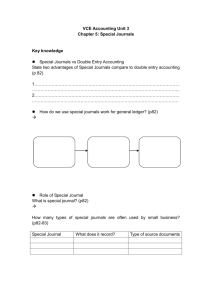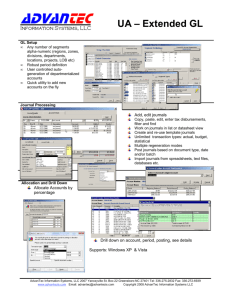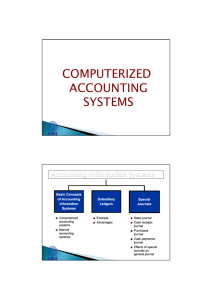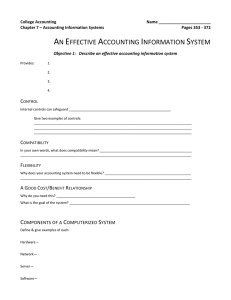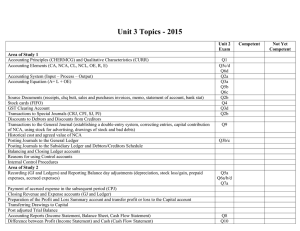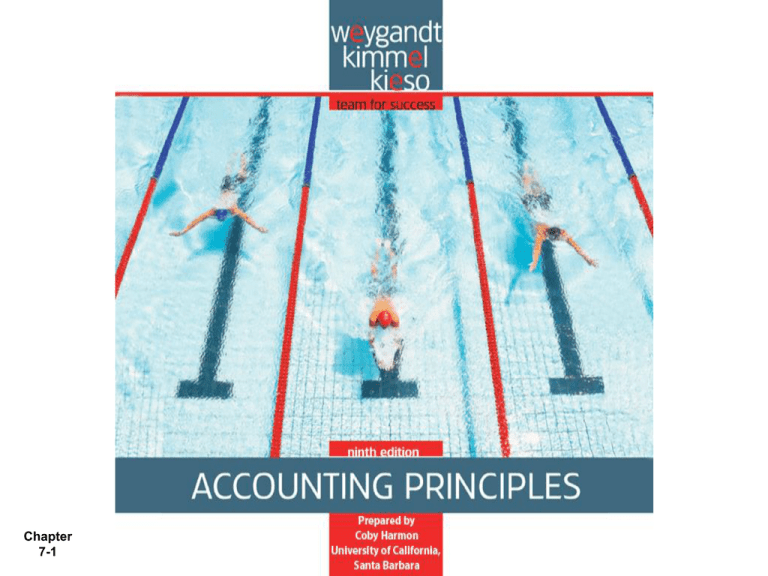
Chapter
7-1
Chapter
7
Accounting Information
Systems
Chapter
7-2
Accounting Principles, Ninth Edition
Study Objectives
1.
Identify the basic concepts of an accounting
information system.
2. Describe the nature and purpose of a subsidiary
ledger.
3. Explain how companies use special journals in
journalizing.
4. Indicate how companies post a multi-column
journal.
Chapter
7-3
Accounting Information Systems
Basic Concepts
of Accounting
Information
Systems
Computerized
accounting
systems
Manual
accounting
systems
Subsidiary
Ledgers
Special Journals
Example
Sales journal
Advantages
Cash receipts
journal
Purchases journal
Cash payments
journal
Effects of special
journals on
general journal
Chapter
7-4
Basic Concepts of AIS
The accounting information system (AIS) collects
and processes transaction data and communicates
financial information to decision makers.
Includes:
All steps in the accounting cycle.
Documents that provide evidence of transactions.
Manual or computerized accounting system.
Chapter
7-5
SO 1 Identify the basic concepts of an accounting information system.
Basic Concepts of AIS
Cost Effectiveness - Benefits
must outweigh the costs.
Illustration 7-1
Principles of an efficient
and effective AIS.
Useful
Output
Flexibility - The system should
be sufficiently flexible to meet
the resulting changes in the
demands made upon it.
Chapter
7-6
SO 1 Identify the basic concepts of an accounting information system.
Basic Concepts of AIS
Computerized Accounting Systems
Software programs (functions include sales,
purchases, receivables, payables, cash receipts
and disbursements, and payroll).
Generate financial statements.
Advantages:
Typically enter data only once.
Many human errors are eliminated.
More timely information.
Chapter
7-7
SO 1 Identify the basic concepts of an accounting information system.
Basic Concepts of AIS
Computerized Accounting Systems
Choosing a software package
Entry-Level Software
Common features and benefits:
Easy data access and report preparation
Audit trail
Enterprise Resource Planning Systems
Chapter
7-8
SO 1 Identify the basic concepts of an accounting information system.
Basic Concepts of AIS
Manual Accounting Systems
Perform each step in the accounting cycle by
hand.
Satisfactory in a company with a low volume of
transactions.
Must understand manual accounting systems to
understand computerized accounting systems.
Chapter
7-9
SO 1 Identify the basic concepts of an accounting information system.
Chapter
7-10
Subsidiary Ledgers
Used to keep track of individual balances.
Two common subsidiary ledgers are:
1. Accounts receivable (customers’)
2. Accounts payable (creditors’)
Each general ledger control account balance must
equal the composite balance of the individual accounts
in the related subsidiary ledger.
Chapter
7-11
SO 2 Describe the nature and purpose of a subsidiary ledger.
Subsidiary Ledgers
Relationship of general ledger and subsidiary ledgers
Illustration 7-3
Chapter
7-12
SO 2 Describe the nature and purpose of a subsidiary ledger.
Subsidiary Ledgers
Advantages of Subsidiary Ledgers
1. Show in a single account transactions affecting
one customer or one creditor.
2. Free the general ledger of excessive details.
3. Help locate errors in individual accounts.
4. Make possible a division of labor.
Chapter
7-13
SO 2 Describe the nature and purpose of a subsidiary ledger.
Chapter
7-14
Special Journals
Used to record similar types of transactions.
Illustration 7-5
If a transaction cannot be recorded in a special journal,
the company records it in the general journal.
Chapter
7-15
SO 3 Explain how companies use special journals in journalizing.
Special Journals
Review Question
Each of the following is a subsidiary ledger
except the:
a. accounts receivable ledger.
b. accounts payable ledger.
c. customer’s ledger.
d. general ledger.
Chapter
7-16
Special Journals
Sales Journal
Illustration 7-6
Under a perpetual inventory system, one entry at selling price in Sales
Journal results in a debit to Accounts Receivable and a credit to Sales.
Another entry at cost results in a debit to Cost of Goods Sold and a
credit to Merchandise Inventory.
Chapter
7-17
SO 3 Explain how companies use special journals in journalizing.
Special Journals
Illustration 7-7
POSTING THE SALES JOURNAL
Companies make daily postings
from the sales journal to the
individual accounts receivable
in the subsidiary ledger.
Chapter
7-18
SO 3 Explain how companies use special journals in journalizing.
Special Journals
Illustration 7-7
POSTING THE SALES JOURNAL
Posting to the general ledger is
done monthly.
Chapter
7-19
SO 3 Explain how companies use special journals in journalizing.
Special Journals
Advantages of Sales Journal
One-line entry for each sales transaction saves
time.
Only totals, rather than individual entries, are
posted to the general ledger.
A division of labor results.
Chapter
7-20
SO 3 Explain how companies use special journals in journalizing.
Special Journals
Cash Receipts Journal
Illustration 7-9
In the cash receipts journal, companies record all receipts of cash.
The posting of the cash receipts journal is similar to the posting of
the sale journal. See complete Illustration 7-9 in the text.
Chapter
7-21
SO 3 Explain how companies use special journals in journalizing.
Special Journals
Review Question
Cash sales of merchandise are recorded in the:
a. cash payments journal.
b. cash receipts journal.
c. general journal.
d. sales journal.
Chapter
7-22
SO 3 Explain how companies use special journals in journalizing.
Special Journals
Review Question
Which of the following is not one of the credit
columns in the cash receipts journal:
a. Other accounts.
b. Accounts payable.
c. Accounts receivable.
d. Sales.
Chapter
7-23
SO 3 Explain how companies use special journals in journalizing.
Special Journals
Illustration 7-13
Purchases Journal
Daily postings are made from the
purchases journal to the accounts
payable subsidiary ledger.
Chapter
7-24
SO 4 Indicate how companies post a multi-column journal.
Special Journals
Illustration 7-13
Purchases Journal
At the end of the accounting
period, the company posts totals to
the general ledger.
Chapter
7-25
SO 4 Indicate how companies post a multi-column journal.
Special Journals
Review Question
All of the following are advantages of using
subsidiary ledgers except they:
a. show transactions affecting one customer or
one creditor in a single account.
b. free the general ledger of excessive details.
c. eliminate errors in individual accounts.
d. make possible a division of labor.
Chapter
7-26
Special Journals
Cash Payments Journal
Illustration 7-16
In a cash payments (cash disbursements) journal, companies
record all disbursements of cash.
The procedures for posting the cash payments journal are similar to
those for other journals.
Chapter
7-27
SO 4 Indicate how companies post a multi-column journal.
Special Journals
Review Question
Credit purchases of equipment or supplies other
than merchandise are recorded in the:
a. cash payments journal.
b. cash receipts journal.
c. general journal.
d. purchases journal.
Chapter
7-28
SO 4 Indicate how companies post a multi-column journal.
Special Journals
Review Question
Cash payments of merchandise are recorded in
the:
a. cash payments journal.
b. cash receipts journal.
c. general journal.
d. purchases journal.
Chapter
7-29
SO 4 Indicate how companies post a multi-column journal.
Special Journals
Effects of Special Journals on the General Journal
Special journals substantially reduce the
number of entries that companies make in the
general journal.
Only transactions that cannot be entered in a
special journal are recorded in the general
journal.
Also, correcting, adjusting, and closing entries
are made in the general journal.
Chapter
7-30
SO 4 Indicate how companies post a multi-column journal.
Copyright
“Copyright © 2009 John Wiley & Sons, Inc. All rights reserved.
Reproduction or translation of this work beyond that permitted
in Section 117 of the 1976 United States Copyright Act without
the express written permission of the copyright owner is
unlawful. Request for further information should be addressed
to the Permissions Department, John Wiley & Sons, Inc. The
purchaser may make back-up copies for his/her own use only
and not for distribution or resale. The Publisher assumes no
responsibility for errors, omissions, or damages, caused by the
use of these programs or from the use of the information
contained herein.”
Chapter
7-31




